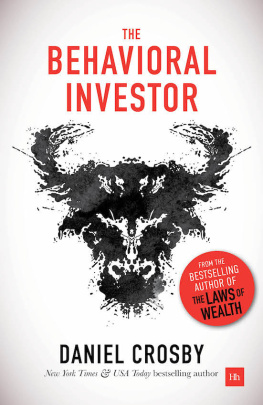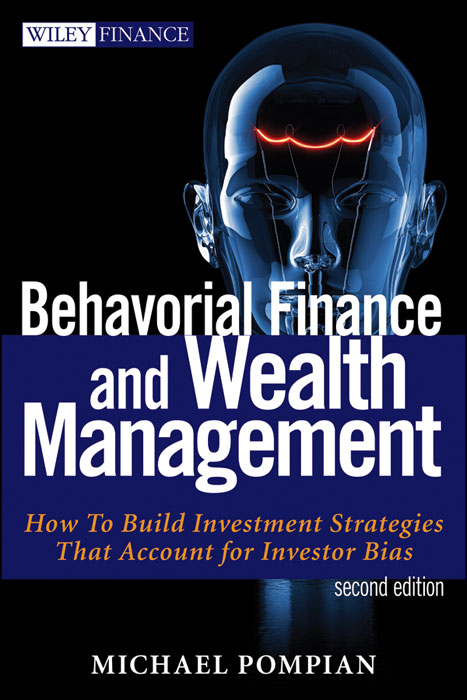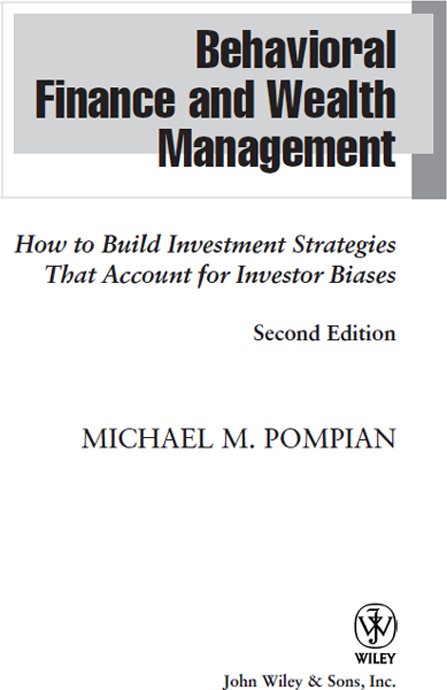Founded in 1807, John Wiley & Sons is the oldest independent publishing company in the United States. With offices in North America, Europe, Australia and Asia, Wiley is globally committed to developing and marketing print and electronic products and services for our customers professional and personal knowledge and understanding.
The Wiley Finance series contains books written specifically for finance and investment professionals as well as sophisticated individual investors and their financial advisors. Book topics range from portfolio management to e-commerce, risk management, financial engineering, valuation, and financial instrument analysis, as well as much more.
For a list of available titles, visit our Web site at www.WileyFinance.com .
Copyright 2012 by Michael M. Pompian. All rights reserved.
Published by John Wiley & Sons, Inc., Hoboken, New Jersey.
Published simultaneously in Canada.
No part of this publication may be reproduced, stored in a retrieval system, or transmitted in any form or by any means, electronic, mechanical, photocopying, recording, scanning, or otherwise, except as permitted under Section 107 or 108 of the 1976 United States Copyright Act, without either the prior written permission of the Publisher, or authorization through payment of the appropriate per-copy fee to the Copyright Clearance Center, Inc., 222 Rosewood Drive, Danvers, MA 01923, (978) 750-8400, fax (978) 646-8600, or on the Web at www.copyright.com . Requests to the Publisher for permission should be addressed to the Permissions Department, John Wiley & Sons, Inc., 111 River Street, Hoboken, NJ 07030, (201) 748-6011, fax (201) 748-6008, or online at http://www.wiley.com/go/permissions .
Limit of Liability/Disclaimer of Warranty: While the publisher and author have used their best efforts in preparing this book, they make no representations or warranties with respect to the accuracy or completeness of the contents of this book and specifically disclaim any implied warranties of merchantability or fitness for a particular purpose. No warranty may be created or extended by sales representatives or written sales materials. The advice and strategies contained herein may not be suitable for your situation. You should consult with a professional where appropriate. Neither the publisher nor author shall be liable for any loss of profit or any other commercial damages, including but not limited to special, incidental, consequential, or other damages.
For general information on our other products and services or for technical support, please contact our Customer Care Department within the United States at (800) 762-2974, outside the United States at (317) 572-3993 or fax (317) 572-4002.
Wiley also publishes its books in a variety of electronic formats. Some content that appears in print may not be available in electronic books. For more information about Wiley products, visit our web site at www.wiley.com .
Library of Congress Cataloging-in-Publication Data
Pompian, Michael M., 1963
Behavioral finance and wealth management : how to build investment strategies that
account for investor biases / Michael Pompian. 2nd ed.
p. cm. (Wiley finance series)
Includes index.
ISBN 978-1-118-01432-5 (cloth); ISBN 978-1-118-18227-7 (ebk)
ISBN 978-1-118-18228-4 (ebk); ISBN 978-1-118-18229-1 (ebk)
1. InvestmentsPsychological aspects. 2. InvestmentsDecision making.;I. Title.
HG4515.15.P66 2012
332.6019dc23
2011039271
I would like to dedicate this book
to my brother Dave and his family.
Preface
It is with great satisfaction that I write this preface. Fifteen years ago, I embarked upon a quest to introduce the benefits of applying behavioral finance in practice with my first published article. Six years ago the first edition of this book was published. In that edition, I noted that behavioral finance was an emerging topic and that, hopefully, it would become a well-recognized discipline in finance. At the time, the debate as to whether or not behavioral finance was to be taken seriously by, mainly, academics and some practitioners, was in full force. Six years on, this debate appears to essentially be over. Behavioral finance is now part of the financial lexicon in many circles, such as the advisor-client relationship, the financial press, the academic literature, financial journals, and so on. It's not whether behavioral finance exists, but rather how can we begin to learn from the research that has been done and help ourselves become better investors. This second edition continues to help both clients and their advisors benefit from the practical application of behavioral finance.
This book is intended to be a guide both to understanding irrational investor behavior and to creating individual investors portfolios that account for these irrational behaviors. The investment business is dominated by benchmarks against which performance of an investment portfolio should be judged. Often, investor think they should beat the market just because that is what they think defines success. In my view, private clients should begin thinking about their benchmarks in terms of how well they help them progress toward their financial goals, not so much whether an investment manager beats their benchmark or their portfolio outperformed the policy benchmark. Knowledge of behavioral biases and their affect on the investment process can go a long way to changing the way we view investment success. Often times, when applying behavioral finance to real-world investment programs, an optimal portfolio is one with which an investor can comfortably live, so that he or she has the ability to adhere to his or her investment program, while at the same time reach long-term financial goals.
The last edition of the book was written in the wake of the run-up in stock prices in the late 1990s and the subsequent popping of the technology bubble. This time, the latest financial bombshell was the 20082009 bursting of the housing and credit bubbles. And given the response to this financial crisis by central banks around the world, by keeping interest rates ultra-low, similar to the years preceding the most recent crisis, my view is we may be in store for continued volatility. Therefore, understanding irrational investor behavior is as important as it has ever been, probably more so. This is true not only for the markets in general but most especially for individual investors. This book will be used primarily by financial advisors, but it can also be effectively used by sophisticated individual investors who wish to become more introspective about their own behaviors and to truly try to understand how to create a portfolio that works for them. The book is not intended to sit on the polished mahogany bookcases of successful advisors as a showpiece: It is a guidebook to be used and implemented in the pursuit of building better portfolios.
The reality of today's advisor-investor relationship demands a better understanding of individual investors behavioral biases and an awareness of these biases when structuring investment portfolios. Advisors need to focus more acutely on why their clients make the decisions they do and whether behaviors need to be modified or adapted. If advisors can successfully accomplish this difficult task, the relationship will be strengthened considerably, and advisors can enjoy the loyalty of clients who end the search for a new advisor.
In the past 250 years, many schools of economic and social thought have been developed, some of which have come and gone, while others are still very relevant today. We will explore some of these ideas to give some perspective on where behavioral finance is today. In the past 30 years, the interest in behavioral finance as a discipline has not only emerged but rather exploded onto the scene, with many articles written by very prestigious authors in prestigious publications and now is consistently in the mainstream media. We will review some of the key people who have shaped the current body of behavioral finance thinking and the work done by them. The intent is to take the study of behavioral finance to another level: reviewing the most important behavioral biases in terms that advisors and investors can understand, and demonstrating how biases are to be used in practice through the use of case studiesa how-to of behavioral finance. We will also explore some of the new frontiers of behavioral finance, things not even discussed by today's advisors that may be commonly discussed in the next 30 years.






![Tim Richards [Tim Richards] - Investing Psychology: The Effects of Behavioral Finance on Investment Choice and Bias, + Website](/uploads/posts/book/124122/thumbs/tim-richards-tim-richards-investing-psychology.jpg)
![Daniel Crosby [Daniel Crosby] - The Laws of Wealth: Psychology and the secret to investing success](/uploads/posts/book/124058/thumbs/daniel-crosby-daniel-crosby-the-laws-of-wealth.jpg)


